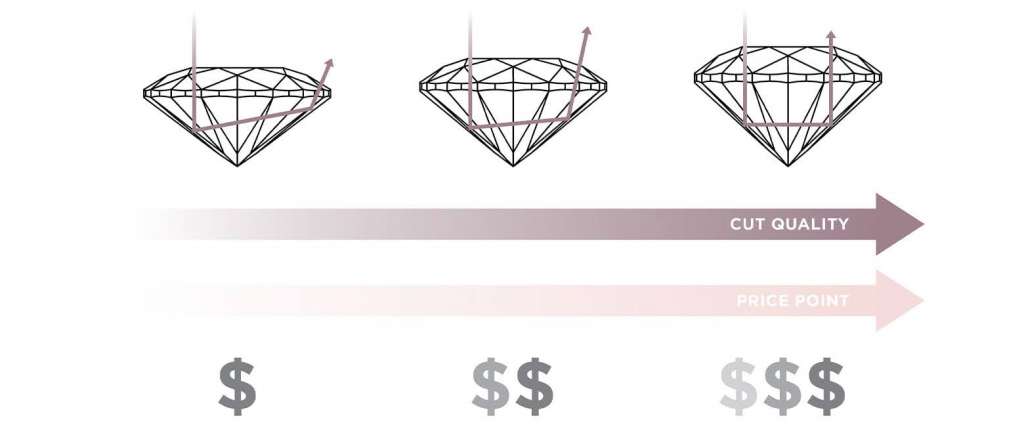While often referred to in the same breath, diamond shapes and cuts are actually two very different things. One term describes a gemstone’s overall appearance while the other is used to determine how well-crafted a stone really is. If there’s one thing that people love about diamonds it’s their unmatched sparkle, and a stone’s cut can make or break this much-adored trait.
In this article, we’ll explore the difference between diamond shape and diamond cut. We’ll also go further into detail regarding diamond grading, stone anatomy and the importance of a well-cut stone.

What Is Diamond Cut?
The term “cut” is used in two ways in the fine jewelry industry. First, to describe the shape of the diamond. For example, terms like pear cut diamond, marquise cut diamond and radiant cut diamond are all used to refer to the unique shape appearance of the stone. However, the true definition of the term cut is used to describe a stone’s proportion, polish and symmetry. When a jeweler or gemologist studies a diamond’s cut they are mainly concerned with how well the stone refracts and reflects white light. While some stone cuts are brilliant and sparkly by nature, others are not. Additionally, some diamond shapes look best when used as an accent or side stone paired with another diamond while other styles work well entirely on their own.
Diamond cuts have evolved over time as trends change and diamond cutters continue to strive for perfection.
How Is Diamond Cut Graded
The Gemological Institue of America (GIA) grades diamond cut according to five categories: Excellent, Very Good, Good, Fair and Poor.
GIA explains each diamond cut grade as the following, “A diamond with an Excellent cut grade is very bright. It shows an even pattern with good contrast between light and dark areas, so the reflections appear crisp and well-balanced. This tells you that the cutter made the best possible use of the rough.” GIA continues stating, ”The Good cut grade diamond isn’t quite as bright – reflections aren’t as sharp and there’s more darkness or dullness in the diamond. The Poor cut grade diamond has much more prominent dark areas or dullness. Given the choice, most people would pick either of the first two diamonds instead of this stone… If all else is equal, an Excellent cut grade pretty much guarantees an extremely attractive diamond. Diamonds in the Very Good or even Good cut grades are also beautiful; they only suffer by comparison with the very best stones.”

To determine a diamond’s cut grade, trusted sources such as the American Gem Society (AGS) and GIA study how successfully a stone interacts with light to create coveted optical effects referred to as brilliance, dispersion and scintillation. Each of these reflections is visually distinct and is achieved using perfectly honed diamond cutting techniques.
Reflection
To determine a diamond’s cut grade trusted sources such as the American Gem Society (AGS) and GIA study how successfully a stone interacts with light to create coveted optical effects referred to as brilliance, dispersion and scintillation. Each of these reflections is visually distinct and is achieved using perfectly honed diamond cutting techniques.
Brilliance
Brilliance, also known as brightness, refers to the internal and external white light reflected from a gemstone.
Dispersion (Fire)
Fire represents the dispersion of white light into a rainbow of colors.
Scintillation
The term scintillation is used to describe how much sparkle a diamond produces. Scintillation also refers to the pattern of light and dark areas created by reflections within a stone.
Stone Anatomy

In order to understand diamond cuts better, it is important to understand the basic anatomy of a diamond. The eight terms described below will give you some baseline knowledge regarding the different parts of a diamond.
Crown
The crown is the top part of a diamond that spans from the girdle to the table.
Pavillion
The pavilion is the bottom portion of a diamond spanning from the girdle to the culet.
Facets
Facets are surfaces of a diamond that can be polished.
Table
The table is the flat surface at the top of the stone.
Culet
The culet is the facet located at the bottom tip of a stone. Preferably, the culet will not be visible to the naked eye.
Depth Ratio
Depth ratio describes the height of a diamond when measured from culet to table.
Girdle
The girdle is a narrow band found on the widest part of a stone, separating the crown from the pavilion. The girdle is sometimes referred to as the “setting edge” as it is where a diamond is held when set in jewelry.
Diameter
Diameter is defined as the width of a stone when measured through the girdle.
Diamond Proportions
Elements such as a diamond’s width and depth are universally measured to determine the quality of a stone. According to The Diamond Pro, “Diamond cut proportions directly affect a diamond’s ability to reflect light and provide brilliance. Proportions are based on the ratios between size, angle and shape of each diamond facet. Various combinations of these elements impact how the diamond will interact with light, which determines its overall beauty and lasting appeal.”
There are three common width ratios of diamond: shallow, ideal and deep. Shallow cut diamonds often appear larger based on their table size, however, light escapes these stones through the sides greatly impacting the diamond’s brilliance, sparkle and fire. Alternatively, when a gemstone is cut too deep, white light is forced to pass through the bottom of the diamond making the stone generally less vibrant and appealing. For the best results, seek out an excellent or ideal cut stone. These cuts are equipped with optimal facet angles to ensure ultimate fire and brilliance.
The Importance of Diamond Cut
Does Diamond Cut Matter?
As you can guess by now, yes, diamond cut matters. Cut quality is incredibly important when choosing a center stone for your engagement ring as the cut is what determines the sparkle and symmetry of a gemstone, two elements that majorly contribute to the overall appearance.
How Cut Grade Impacts Price
Out of all of the 4Cs, the cut of a diamond is what most significantly impacts the stone’s beauty. This is why gemstones with higher cut grades are priced significantly lower than those with low cut grades. However, many jewelers and customers alike argue that the high price tag is worth every penny as it’s often recommended to spend more on diamond cut than on diamond clarity or diamond color grade.

Cut quality is often the determining factor when it comes to a stone’s value and price, however, other things such as proportion, symmetry, brilliance, fire, scintillation and finishing details can impact the final cost, too.
Diamond Cut and Symmetry
According to the GIA, while proportion is typically an important factor to consider when shopping for diamond engagement rings, it isn’t the end-all-be-all when it comes to a well-cut diamond. “The whole is greater than the sum when it comes to a diamond’s proportions, which are the dimensions and angles of a polished diamond’s facets and how they relate to one another. There is no set “formula” or set of proportions that result in a perfectly cut diamond. All of the numbers you might have heard other people referring to – table size, crown angle, pavilion angle – work together to create the spectacular stone sitting in from of you.”
GIA continues stating, “There are a range of proportions that fall within each cut grade, and each specific diamond within that grade may look slightly different in terms of attributes like brightness, fire or pattern. For this reason, a specific stone may be more appealing to one customer than another, even though both may perform equally well.”
The preferred diamond cut grade varies from person to person. While one person might be drawn to a stone with a high cut grade, you might prefer a diamond with a lower cut grade.








Leave a Comment